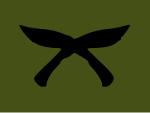History
The regiment was formed as the sole Gurkha infantry regiment of the British Army following the consolidation of the four separate Gurkha regiments in 1994: [2]
The amalgamations took place as follows:
- 1st Battalion, Royal Gurkha Rifles; formed by the consolidation of the 1st Bn, 2nd King Edward VII's Own Gurkha Rifles and 1st Bn, 6th Queen Elizabeth's Own Gurkha Rifles.
- 2nd Battalion, Royal Gurkha Rifles; formed by renaming the 1st Bn, 7th Duke of Edinburgh's Own Gurkha Rifles.
- 3rd Battalion, Royal Gurkha Rifles; formed by renaming the 1st Bn, 10th Princess Mary's Own Gurkha Rifles.
The 3rd Battalion was consolidated with the 2nd Battalion in 1996 as part of run down of British forces in Hong Kong. [3]
The Gurkhas in general and the direct predecessors of the Royal Gurkha Rifles in particular are considered to be among the finest infantrymen in the world, as is evidenced by the high regard they are held in for both their fighting skill, and their smartness of turnout on parade. [4]
In December 1995, Lieutenant-Colonel Bijaykumar Rawat became the commanding officer of the 1st Battalion, the first Nepalese to become a battalion commander in the RGR. He oversaw the departure of the battalion from Hong Kong just before that city's transfer to Chinese control, and the battalion's relocation to Queen Elizabeth Barracks, Church Crookham in 1996. [5]
Twice during its most recent Brunei posting the 2nd Battalion was deployed as the Afghanistan Roulement Infantry Battalion, while the 1st Battalion deployed as part of 52 Infantry Brigade in late 2007. During this tour, Cornet Harry Wales (Prince Harry) was attached for a period to the 1st Battalion as a Forward Air Controller. [6]
Under Army 2020, the regiment was intended to provide two light role battalions, rotating between Brunei and the UK, with their higher unit as 11th Infantry Brigade. [7] However, in June 2015, the 2nd Battalion, then based in the UK, was reassigned to form part of 16 Air Assault Brigade, in the air assault infantry role. [8]
In 2018, the UK Government announced that it intended to recruit more than 800 new posts to the Brigade of Gurkhas. [9] Approximately 300 of these are planned for the Royal Gurkha Rifles, which was to see the formation of a new battalion planned for the specialist infantry role. [10] On 11 March 2019, the Minister for the Armed Forces confirmed that the 3rd Battalion Royal Gurkha Rifles would be reestablished, with recruitment starting in 2019. [11] The battalion was reformed on 31 January 2020, to be based initially at Shorncliffe before moving to Aldershot. [12] However, following the revised Future Soldier (British Army) reorganisation, the formation of the 3rd Battalion was cancelled, with instead a number of independent companies established. The first formed unit, Coriano Company, within 4th Battalion The Ranger Regiment. This was subsequently followed by Falklands Company, within 2nd Battalion, The Rangers. [13] A third reinforcement company, Krithia Company, was formed in April 2024 as part of 1st Battalion, The Rangers. [14]
Organisation
At any one time, one battalion is based at the British garrison in Brunei as part of Britain's commitment to maintaining a military presence in Southeast Asia. [15]
Meanwhile, the other battalion is based at Sir John Moore Barracks, Shorncliffe, near Folkestone in Kent as part of 16 Air Assault Brigade Combat Team, and is available for deployment to most areas in Europe and Africa. [15]
1 RGR and 2 RGR rotate between Brunei and Folkestone, typically every 3 years. [16]
Krithia Company, Coriano Company and Falklands Company operate as part of the Army Special Operations Brigade providing training, mentoring and operational support for indigenous forces in partner nations, and is based in Aldershot Garrison. [17] [18]
Gurkha clerks
Prior to 2011, administrative support for the entire Brigade of Gurkhas was provided by specially trained personnel called Gurkha clerks, who wore the cap badge of the Royal Gurkha Rifles. In June 2011, the Gurkha clerks were amalgamated into a single company sized unit called the Gurkha Staff and Personnel Support Company (GSPS), which was incorporated as part of the Adjutant General's Corps. As with the other Gurkha support units (Queen's Gurkha Engineers, Queen's Gurkha Signals, Queen's Own Gurkha Logistic Regiment), the GSPS received its own cap badge based on the badge of its parent corps. [23]
Ranks
Upon joining the British Army the RGR's predecessor regiments adopted British rank titles (e.g. sergeant and corporal) instead of the Indian Army names used before (e.g. havildar and naik). Similarly, the regiments' Viceroy Commissioned Officers, who were neither commissioned officers nor non-commissioned officers but filled most of the junior officer positions in a battalion, had their titles changed to (King's) Queen's Gurkha Officer (QGO), e.g. lieutenant (QGO), captain (QGO), major (QGO) instead of the Indian Army ranks of jemadar, subedar, and subedar-major. [24] At the same time, some RGR Gurkha officers had a Queen's Commission; they often had a (GCO) suffix after their rank. [25]
Subsequently, on 17 June 2008, the London Gazette published a Supplement that effectively abolished the QGO system by listing every serving QGO officer with their new commissioned rank (e.g. captain (QGO) became captain); the (QGO) and (GCO) suffixes disappeared. [26] Thus, serving Gurkhas, who previously would have become QGO, are now given a British commission and described as "Late Entry." Direct entry officers can be either British or Nepali (occasionally); they follow the normal British Army training for all direct entry infantry officers. A significant addition to the normal direct entry training for British RGR officers is that they will carry out Nepali language training in Nepal, which culminates in a month-long hike through the Nepalese countryside both to practise their language skills and learn about the country from which their soldiers are recruited. [27]
This page is based on this
Wikipedia article Text is available under the
CC BY-SA 4.0 license; additional terms may apply.
Images, videos and audio are available under their respective licenses.



